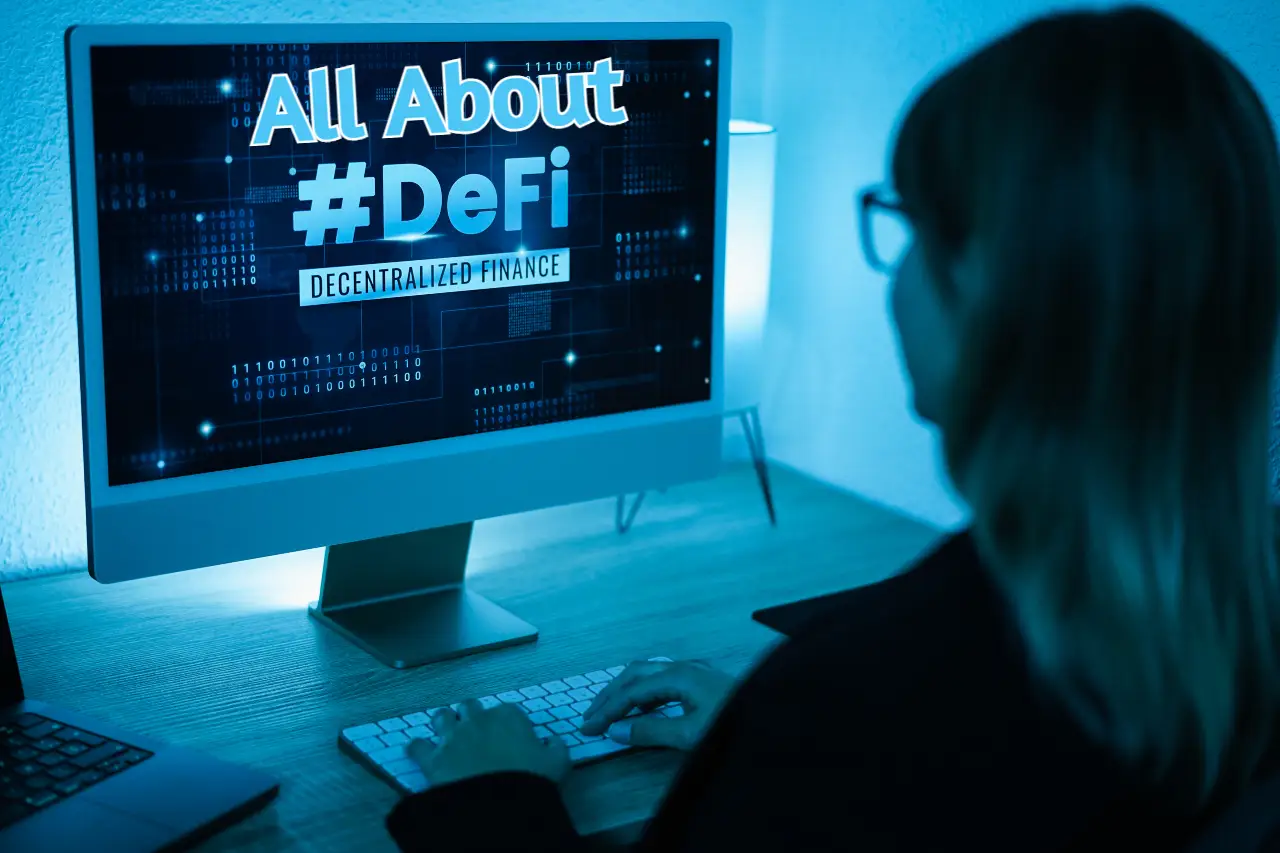For someone just starting in the world of cryptocurrencies, it can be a little hard to figure out where to start – and many stories have been created about lost fortunes. This article will not guide you on how to “Mine” for cryptocurrency, but it will give you a brief overview of what DeFi is and how they differ from tokens.
This article mainly solves your queries related to DeFi like What is DeFi?, Can I get interested in Holding DeFi coins, Can it change the future of the finance system? and it is risky or not?.
Hello Guys, welcome to the new informative article on the DeFi system. If you read my previous article, you are already familiar with Cryptocurrency and Bitcoin. As I already mentioned in my last article, Bitcoin is a decentralized system, which means it is not controlled by central government bodies like banks and other financial institutions. It can be sent to anyone and anywhere without the help of any financial institution.
Bitcoin is decentralized money, and in today’s article, we will learn about Decentralized finance. If you are willing to learn more about bitcoin, please read “History of Bitcoin“.
Table of Contents
Centralized Finance System
The primary purpose of the Finance system is to send/receive money and additional services that we get from the financial system. We use insurance, loan saving plans, Trading funding programs, and other services built around money. Our current financial services and system are centralized. Banking institutions, Stock markets, Capital, insurance, and other financial companies have a person or company behind them that controls the whole system. And all the financial companies or institutions are governed by the rules and regulations of their country’s central bank. A centralized financial system has both advantages and disadvantages, some of which I listed below:
Advantages of Centralized Finance
- More Flexible and easy to use as compared to DeFi.
- Allow exchanging fiat to crypto and crypto to fiat.
- The company manages funds, and they give good customer service and support if needed.
- Diversified services and options.
- Cross Chain Services.
Disadvantages of Centralized Finance
- High Transaction fees and service charges.
- Not safe from hackers
- Transparency is questionable
Decentralized Finance System
DeFi is a term given to such a financial system with no central authority for managing and controlling. By using cryptocurrency and its algorithm, we can create some financial companies like insurance, loans, and exchanges that are auto-operated based on the algorithm; such financial companies or institutions are known as decentralized finance systems.
Confused? I will explain it in simple words. For creating decentralized finance, we need some infrastructure for programming and running decentralized services. We need to run or build the DeFi system are Blockchain, Smart Contracts, and cryptography. For enabling Decentralized Finance, intelligent contracts are required. Smart contracts are the set of code that runs automatically and verify that specific terms and condition is met or not. Such platforms are essential for creating Decentralized Apps (Dapps), which work automatically based on the algorithm. Smart contracts automatically manage and run the centralized application, making such an app out of anybody’s control.
Five Pillars of DeFi System
DeFi system needs some infrastructure for their efficient run and build. All the major components that need to hold the DeFi system up are listed below with a brief explanation.
1. Stablecoins
First, we need to understand the bridge between centralized fiance and decentralized finance. We need a cryptocurrency that matches both cryptocurrency and real-world currency; yes, I am talking about Stablecoin. Dai, Tether, and USDC are some examples of stable coins that match a real-world asset. Stablecoin’s price is tied to the united states dollar, making them durable, making Stablecoin almost zero volatile and can be used as a standard payment method.
Now let’s talk about the role of Stablecoins in the Defi system and how it is beneficial?. Let me explain with some examples; if you want to trade through a centralized finance system like Binance or Coinbase, you need to pay high service fees and are also liable to pay tax on your profit. But If you do the same thigh through the decentralized system, you can initially convert your Fiat to Stablecoins. And choose any coins that may give high returns like Ethereum or Solona and buy with your Stablecoins. Buying crypto with Stablecoins done inside the decentralized system, there is no involvement of Central bodies, and there is no need to pay taxes and charges to any central bodies. The smart contract checks the buying of crypto with Stablecoin and charges less the 0.5% of the fee.
There is a high risk of hacking in centralized finance systems also. But there is no risk of fund loss or being hacked on a decentralized system. And by using Stablecoins, we can do all the trade and transactions without the involvement of central authorities, and If we need a fiat cashout, we can send our Stablecoin to exchange and get a Fiat balance. We already know that Stablecoins are pegged to USD, so there is no need to pay more exchange fees while withdrawing. Every country has a specific limitation on how much transaction is done per transaction, per day, and month. With the help of Stablecoins, we can remove this restriction and do it with a meager fee.
2. Borrowing and Lending
Lending and borrowing is other major component of decentralized finance. Since our current financial situation relies so heavily upon lending and borrowing money, we think the blockchain could do this part of the financial system better. This is possible because one of the reasons we can lend and borrow with banks is due to collateral (putting something down) such as a 20% deposit for example. If we don’t pay back the loan completely, then our government can come after us and throw us in jail or make us pay that money.
In short, there is legal recourse for not paying back a loan with cryptocurrency. This can be problematic because one of the benefits of cryptocurrency is anonymity. A person can put down one deposit and then escape by taking off with all of the rest of the money before returning, which can cause problems in various ways. We can solve this issue by using smart contracts to allow users to borrow funds from others while still keeping custody of what was given away.
So let’s take an example. Person A wants to earn interest on his coins, while Person B wants to borrow some coins. So Person A goes to aave and compounds, which are two platforms that allow crypto borrowing and lending, and deposits his coins into the companies’ smart contract system.
If you don’t know already, smart contracts are code that executes programs and functions on the blockchain. In turn, what they get is called C tokens or A tokens which represent the content owner’s original coin plus interest . The owner can use A tokens with certain content platforms to get his original deposit back and also earn interest as well.
Further smart contact made with such a complexity that no human can do such transaction and needs computers for the calculation. It is code automated
Now, decentralized applications are able to be used by users. To clarify, a decentralized application or dApp is simply a platform that is run on a virtual network which makes it so businesses and other people are not at the will of a third party. Due to this reason, companies and sometimes individuals may use smart contracts (software code) as opposed to legal contracts. By doing this, we allow businesses to consolidate their efforts and maintain financial security as well.
Now, at this point, you might be asking yourself: What’s the point of taking a loan if I have the money? Well, your thought process is probably stemming from where we are in the United States of America (and other nations) right now today as our nation is governed by dollars. The way that dollars are constructed is such that one can say they have ten Ethereum worth $1000 because even though each of said Ethereum has a value of one hundred dollars, they’re interchangeable. This means you can exchange your Ether to buy a fiat cryptocurrencies like Bitcoin so you could take out a loan against it and use it as a down payment for your home or car!
((( So you put them up as collateral and borrow eight hundred dollars worth of Tether, which is a Stablecoin pegged to the United States dollar. So you trade that eight hundred dollars around, you make some money, you lose some money, you make some more money, and now it’s time to pay back your loan. )))
((( Now you have eight hundred and fifty dollars in Tether, and you pay back the original $800 loan to get back your 10 Ethereum. Well, and this is a little example you made fifty dollars from the minor trades you did, and you got lucky. But it has also been a few months, and Ethereum, as it has done in the past few months, exploded, and now they’re worth one hundred and fifty dollars each. )))
((( So now you have 10 Ethereum at one hundred and fifty dollars each. So now you control one thousand five hundred dollars plus the fifty dollars you made trading. If you believe in Ethereum and you have it but don’t want to sell it, and you want to use its value, you can take a loan out on it, hoping that it will be worth more whenever you cash it out. However, if you traded, you lost some money, you gained some money, and then you lost some money, and maybe you ended up with seven hundred and fifty dollars tether. )))
((( You would have two options. Option A is to front the extra fifty dollars to pay back the entire loan. The $800 to get back all of your collateral and Option B is to keep your seven hundred and fifty dollars and lose your 10 Ethereum, which could be worth a lot. Now, this might be information overload, but real quick. There is a second type of loan in crypto called a flash loan, which is a loan that lasts for like 10 seconds. )))
((( You could buy an Ethereum for $10 on Coinbase and then sell it for $11 on Gemini. Theoretically, you can make a dollar every time you do that, and so you can use what we call is a flash loan to borrow millions of dollars. You don’t have to put any money down for a flash loan to borrow $10 million. You tell it to buy Ethereum for $10 and then immediately sell it for eleven. )))
((( And then you pay back the original loan of $10 million and all one minor little smart contract that gets run in 10 seconds. Essentially, you made a million dollars minus the fees you had to pay for borrowing. But these fees are small because the lender knew that you would have to pay them back and that it was for a brief period. This is a more advanced technique, but you could never perform this type of arbitrage in traditional finance. )))
3. Decentralized Exchanges
I have a friend who travelled to London a few years ago from the United States. Now, of course, in London, the standard currency is euros, while over here in the U.S., it’s dollars. So naturally, he had to visit a foreign exchange booth and trade out his dollars for euros. Unfortunately for him, the fee was like 15 per cent, so he immediately lost 15 per cent of his money because that’s what foreign exchange traders do. Tourists don’t know any better, and they need local money. So what they do is they take advantage of these people well when it comes to decentralized finance instead of a foreign exchange trader; we have what is called a decentralized exchange where you can exchange your coins and tokens for other coins and tokens.
The fees are usually minimal, like less than half of a per cent, which is an excellent benefit for anyone who regularly wants to trade their crypto assets. Most popular decentralized exchanges, or DEXs, work where investors pool their money together, and then traders can change that money. The fee of every trade I mentioned earlier goes back to those investors, and it’s all written in code, so it doesn’t change. A government can’t step in and say, you can’t buy bitcoin anymore. The fees and the percentages that you change are locked to. They’re written in code, so they don’t change and can’t raise crazy prices like 15 per cent.
Decentralized exchanges open the world to a whole new variety of tokens and coins. For example, Coinbase, the first centralized exchange to go public, only allows you to buy and sell 32 cryptocurrencies at the moment since they are regulated by the government and have to abide by specific regulations. They very closely analyze each coin before adding it. The most popular decentralized exchange, Uniswap, literally has hundreds, maybe even thousands of tokens that you can trade, and no one regulates them. That’s the decentralized part. There are billions of dollars locked up in these liquidity pools so traders can change, but nobody can control these billions of dollars. They’re just following a program that someone wrote. Only investors can be the ones to pull their money out of the pool. But if they did that, the lending rates would rise, so new investors would come along and put their money in. So like I said earlier, the code can’t be changed either. It’s what we call immutable. So in the crypto space, we like to say that the code is the law. The government doesn’t control it. The code does, and everyone has access to it, and it doesn’t change.
Uniswap is one of the major exchanges on the Ethereum network, and it has billions of dollars in its pools. Pancakeswap is another exchange on the Binance Smart Chain network with a few billion dollars of liquidity.
4. Insurance
Insurance is straightforward to explain. For example, you pay one hundred dollars a month to protect your new Tesla with car insurance. However, one day, while using the Autopilot feature, another car causes the Autopilot to glitch, and you drive into a ditch unharmed, though. Still, you’d wreck the car well since you paid insurance the insurance company pays you with the Tesla was worth so that you can buy a new one. They use statistics to predict how many of their drivers will crash their cars and then use this data to indicate how much they would have to pay each year to determine the monthly price of the insurance, which is also called the premium.
Well, with decentralized finance, the insurance company can be code, so let’s go over an example. Let’s say a farmer wants to buy crop insurance, so if his crops die, he still has income for planting them and taking that risk. We could write a piece of code on the Ethereum network that says if there are any days this summer that is 90 degrees Fahrenheit or hotter four days in a row, payout farmer Joe $100000. However, to start this contract, he has to pay $2000 so farmer Joe can buy his crop insurance through a smart contract, which is just a code that sees if the conditions are met to pay him.
So at this point, you might have two questions How does the code know if it’s ninety-five degrees Fahrenheit? And where does $100000 come from? To connect the real world to the blockchain, we have to use something called oracles, which are trusted. Sources become a bridge between the natural world and the crypto world. We can create an oracle in our city that reads the temperature and is verified by a few people to ensure that it can’t be frauded. Then the smart contract can reliably use it as a data source to decide if insurance requirements are met or not.
Secondly, the one hundred thousand dollars comes from other people buying insurance that bought the premiums, but maybe they didn’t get paid out because the requirements were not met. Just like an insurance company makes a profit, people who provide liquidity to any decentralized finance platform may be incentivized with an interest rate to earn on their deposits. In other words, some of the $100000 may come from investors who make money by lending their money.
5. Margin Trading
Lastly, we have number five, which is margin trading, so margin trading is a whole new beast. Let me explain margin trading in the traditional world real quick, and then I’ll explain it in the decentralized world. So you want to buy the Apple stock, and right now, it is one hundred dollars. So essentially, what margin is, is it is a loan that will automatically sell your cache if the stock goes below your down payment. In order to buy one hundred dollar stock, you need a one hundred dollars loan, and the bank agrees to give you that one hundred dollars loan if you can give them a $20 down payment and a small fee of five per cent a year.
Let’s explain with two scenarios that could happen. The stock goes from one hundred dollars to one hundred and fifty dollars. You have paper hands, so you decide to sell the stock, and you get one hundred and fifty dollars. You pay back eighty dollars of your loan because the bank already had your original 20 as a down payment, and you keep the rest, which is a profit of $70. So essentially, you made $70 by only spending $20. This means that you more than tripled your money, even though the stock only went up 50 per cent. This is the power of margin.
You use it when you think something will increase in value to multiply your own money.
Now, let’s take a look at another situation. This is the second scenario if the stock drops to 50. Well, with margin, you have to sell as soon as the value of what you bought can’t pay back your loan, so the stock starts at one hundred dollars, then it starts dropping ninety eighty-five and then as soon as it hits 80. Boom. The bank forces you to sell your one stock of Apple at $80 so that you can pay them back those eighty dollars that you borrowed.
So the eighty dollars you made from selling the stock, plus the twenty dollars you gave them as a down payment, equalizes the loan, and now the bank has the original $100 they initially gave you. So you’re free and clear you’ve paid your loan back, but you didn’t profit anything, and you lost your original twenty dollars that you put up as a down payment.
In centralized finance, to trade on margin, you usually need to prove who you are, along with having a minimum of a few thousand dollars even to have access to margin trading. The fees are also much higher, much higher than five per cent, and decentralized finance margin trading could be a lot quicker open to anyone in the world with money and a lot safer as well.
Characteristics of a DeFi System
Developers need to implement the smart contract portion of the fundraising platform to be classed as a DeFi. A DeFi coin works best when it is created with an ecosystem in mind, providing incentive for all parties involved. They can do this by using an Adhoc token reward algorithm, which works with both investor speculation and user adoption in mind. This article provides more detailed information about the characteristics of the DeFi coin, advantages, and disadvantages listed below:
Characteristics
- No problems with liquidity
- Secure platforms and almost zero per cent chance of hacking or scam
- Less expensive than traditional centralized finance
- Anyone can access DeFi. No barriers like Age limit, location, or territory.
- Highly transparent
Advantages
- No one has control over our funds
- No barriers and restriction
- Highly secured system. Almost zero chance of hack and scam
- Low transaction fees and service charges
- High-interest rate
- Lending and Borrowing Application
- Transfer of money happens in few minutes
- It is open 24/7
Disadvantages
- Highly volatile, and the price prediction is uncertain
- Total supply is limited and must need to fix at the time of the creation
- Doubt on taking responsibility because of no backing system or person or company.
How DeFi works
DeFi uses Cryptocurrencies, blockchain technology, and smart contracts, which eliminate the requirements of intermediate bodies like banks and other financial institutions. In the present work, financial institutions and companies are backed by some person or company and regulated under the rules and regulations of the central bank or government authorities; this way, the central bank and government authorities have the power to access our funds. But in DeFi, there is no middle man and intermediaries; DeFi automatically works on their algorithm as per defends. So the DeFi is not managed and controlled by anyone; the owner is solely responsible for holding their private key to access their funds.
The working of Decentralized finance is nearly similar to our Centralized finance. In centralized finance, total monetary value and flow are managed/controlled by the central authorities who backed it. And similarly, in Decentralised fiance, the whole financial activities are governed by the set of algorithms called smart contracts that were defined before creating the DeFi system. DeFi has more transperineal, and there is no chance of hacking or scam. The smart contract is stored on the open-source library, and anyone can check through the explorer, which stops scams with our fund like in a centralized finance system.
Currently, few altcoins support smart contracts and decentralized apps (Dapps) that create the perfect environment for the DeFi system. Ethereum, Binance Smart Chain, Polygon, Celo, Fantom, POA Network, etc., are examples of some popular altcoins that support smart contracts.
Different Types of Defi System
DeFi Coins represent a new way of holding, managing, and investing in digital currencies. DeFi coins and tokens come with unique and advantageous features that yield exponential financial profits. Some types of Defi Coins include decentralized lending, decentralized exchanges, decentralized storage, and token staking.
Conclusion
To survive, cryptocurrencies need to get away from their dependence on Bitcoin. If one of the cryptocurrencies is heavily invested in Bitcoin, it will fall when Bitcoin does. It may not be a 100% accurate form of investment, but if you have faith in blockchain and have held onto your cryptocurrency through the last few years, then you may see an excellent return. Yes, I am talking about investing in decentralized finance.
In this article, I am covering All About DeFi and The Things You Need To Know, it like its pros, cons, working mechanisms, and many more. If you love this Defi explanation article, and this article may add value to your knowledge database, please comment on us. If you love this article, you may like another similar article on “All About Stablecoins.” We are always happy to hear from you, and your comment is our motivation. Thanks for reading my hard work, and so glad to see you again in my next article. Bye-Bye.








